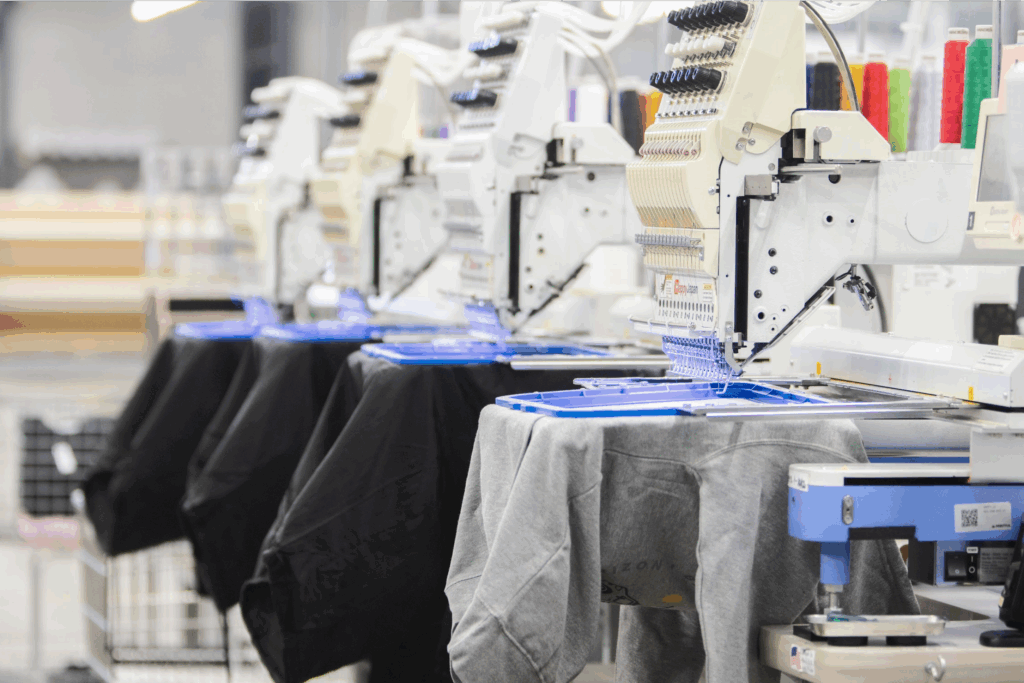Sell custom products without inventory
New Mexico tariffs are changing North American trade, affecting sourcing costs, product pricing, and delivery speeds – and print-on-demand (POD) merchants are feeling the impact.
These tariffs are part of President Trump’s evolving trade strategy, hitting closer to home than previous measures on imports from China.
In this article, we’ll break down what’s happening, what it means for your business, and how Printify is helping you stay competitive with agile solutions like Printify Choice.
This article is for informational purposes only and should not be considered legal or financial advice. While we strive to provide accurate and up-to-date content, global trade policies are subject to change. Always consult with a qualified professional before making business decisions related to tariffs, imports, or pricing, especially with respect to evolving international trade laws.
Key takeaways
- The US has imposed 25% tariffs on imports from Mexico as of April 2, 2025. Products fulfilled locally in the US are generally not affected by these tariffs.
- These tariffs affect both finished goods and raw materials used in manufacturing, potentially raising prices for POD sellers. Unlike tariffs on Canada, Mexico’s energy resources are not exempted.
- Tariffs are often intended to protect domestic industries, but they can disrupt the supply chain and increase costs for businesses and consumers.
- Printify Choice helps merchants dodge tariffs by routing orders through a global network of local providers, keeping costs low and deliveries fast.
- While prices are stable for now, we’re monitoring the situation closely to help merchants navigate these changes as they continue to unfold.
What is a tariff, and how does it work?

A tariff is a tax imposed by a government on goods imported from other countries. This makes foreign products more expensive, encouraging consumers to buy local and helping protect domestic industries.
But tariffs also raise costs for businesses that rely on international trade, like POD sellers sourcing blanks from abroad.
Tariffs are typically collected at the border, and they’re added to the total cost of importing a product.
That means when a company imports a $10 t-shirt with a 25% tariff, the total cost becomes $12.50. Depending on the pricing strategy, this extra cost often gets passed on to customers or cuts into sellers’ margins.
Tariffs can be part of a global trade strategy or used in response to specific trade issues between countries. We saw similar strategies during President Trump’s first term, particularly in trade disputes involving China.
Types of tariffs
Ad valorem tariffs
These are percentage-based. For example, a 10% tariff on a $100 item adds $10 in duties. This type is common and adjusts based on product value.
Specific tariffs
These are fixed amounts charged per unit, such as $3 per item, regardless of its value.
Retaliatory tariffs
These are a response to tariffs imposed by another government. For instance, when the US imposes tariffs on Mexico, Mexico may retaliate with its own tariffs on American exports.
How are they imposed, and who pays the tariffs?
Tariffs are typically enacted through executive orders or trade legislation.
In the US, many of President Trump’s tariffs – including those on Mexico, China, and Canada – were issued under the International Emergency Economic Powers Act (IEEPA).
Importers (often fulfillment centers or wholesalers) typically pay the tariffs. However, the cost tends to flow downstream – to you as the seller, and ultimately to your customers.
Until recently, the IEEPA has been used to justify emergency trade measures in response to national or economic security threats.
However, the scope of that authority is currently under legal review. In August 2025, the Federal Circuit ruled that the IEEPA does not authorize the president to impose certain tariffs – particularly reciprocal and fentanyl-related tariffs – stating that the power to regulate imports does not include setting tariff rates.
The ruling will not take effect until October 14, 2025, and the case is now pending before the US Supreme Court, which is expected to rule sometime in 2026. Until then, the tariffs remain in effect.
The current situation of the tariffs on Mexican goods
On February 4, 2025, President Donald Trump announced a new 25% tariff on all imports from Mexico, implementing tariffs aimed at reshaping regional trade dynamics.
This move followed similar measures taxing imports from China and Canada as part of a broader economic strategy. This is to strengthen US manufacturing and address what the administration describes as unfair trade practices.
According to the White House, the reciprocal tariff policy is intended to rebalance trade and assert greater control over cross-border production dependencies.
In response, Canadian and Chinese officials have pushed back with their own retaliatory tariffs.
While some Mexican imports are subject to the new 25% tariff, USMCA-compliant goods remain exempt under the existing trade agreement. The USMCA continues to grant duty-free treatment to qualifying goods that meet the agreement’s rules of origin.
However, products that fall outside these criteria – including those with non-regional components or insufficient local content – are now subject to the full tariff as of April 2, 2025. Businesses must verify compliance and adjust sourcing strategies accordingly.
Why Mexico tariffs matter
Mexico is one of the US’s largest trading partners, especially in the manufacturing and agriculture sectors. The two nations have deep supply chain ties, with some products assembled in the US often relying on parts or labor from Mexico.
So, when high tariffs are imposed, the impact stretches across industries, especially for cross-border exporters serving US markets.
Mexico’s response to tariffs has already been indicated by the country’s officials, signaling potential additional tariffs on US goods in retaliation.
This could lead to further global trade disruptions and more pressure on companies to adapt quickly, as ongoing tariff responses are expected from both sides.
Latest de minimis update
On July 30, President Trump signed an Executive Order removing the de minimis exemption for imports into the US.
Effective August 29, 2025, all goods valued at $800 or less that previously avoided duties will now be subject to them.
- Non-postal shipments (couriers, freight): Subject to all duties, taxes, and fees.
- Postal shipments: Temporarily assessed by ad valorem duty (tariff rate under IEEPA), or flat rate duty ($80-$200 per item, available for six months only).
After that six-month window, all carriers must collect duties at the full reciprocal ad valorem tariff rate based on the product’s origin country.
For POD sellers, this ends the under $800 duty-free advantage and means every cross-border shipment could face additional costs.
What is the economic impact of Mexico’s tariffs?
Tariffs raise the overall cost of doing business, and the effects are already rippling through industries like eCommerce and Print on Demand.
The new tariffs on Canada and Mexico introduced under the Trump administration not only affect raw materials and product pricing – they also influence broader economic trends like inflation, slowed sales, and shifts in supply strategy.
Here’s how the economy could be affected.
- Inflation pressure: As import costs rise, so do consumer prices, especially in industries dependent on international supply chains. That may reduce disposable income and lower spending.
- Reduced trade volume: Higher duties make it more expensive to move goods across borders, which affects the performance of export-heavy economies such as Canada’s GDP over time.
- Impact on small businesses: Merchants with limited margins may find it harder to compete or maintain profitability. In some sectors, reduced demand could affect manufacturing and fulfillment jobs tied to cross-border trade.
- Shipping delays: Customs clearance may take longer due to increased inspections, processing, and growing non-tariff barriers.
- Disrupted supply chains: Companies may be forced to reorganize logistics and switch to domestic suppliers or lower-tariffed regions. Workforce reductions may also occur in highly impacted sectors.
- Slowed innovation and deregulation setbacks: As companies focus on managing costs, fewer resources go toward growth, product development, or adapting to new market conditions.
For print-on-demand sellers, this could mean increased production and fulfillment costs for customizable products like t-shirts, mugs, and posters – especially if they’re sourced from or routed through Mexico.
With demand-sensitive pricing and international buyers, even small cost increases can affect sales volume and margins.
Effects on print-on-demand businesses
Tariffs can influence multiple aspects of Print on Demand, but with the right approach, you can stay agile and profitable.
Here’s what sellers should keep in mind.
- Blank products: While many POD blanks are imported, even US-based Print Providers may source materials or components from Mexico or other tariffed countries. That means some products could see moderate cost increases depending on their origin.
- Fulfillment costs: Tariffs may increase production or import expenses for certain items. However, the actual impact will vary depending on which countries, materials, and providers are involved.
- Delivery times: In some cases, non-tariff barriers like increased customs checks, import quotas, or new documentation requirements could lead to shipping delays.
- Profit margins: Sellers may need to review pricing strategies. Some merchants may choose to absorb small increases, while others adjust prices to maintain healthy margins.
Not all products will be affected, and many Printify merchants are already set to adapt quickly.
With tools like Printify Choice, you can route orders through local production partners to minimize exposure to tariffs and keep operations running smoothly – more on that later.
Tariffs may be part of a larger strategy to boost economic growth, but for POD sellers, success lies in staying flexible and optimizing your supply chain. By monitoring changes and using the right tools, you can continue to grow even in a shifting trade environment.
Dodge tariffs with Printify Choice
Here’s the good news – you’re not alone. Printify offers a smart solution for minimizing the impact of tariffs on imports.
Printify Choice is a fulfillment system powered by smart algorithms. Instead of relying on one Print Provider, Printify Choice automatically selects the best production partner for each order based on cost, speed, and location.
Why it works
- Local fulfillment: Orders are routed to local providers whenever possible, dodging tariffs by eliminating cross-border shipping.
- Lowest prices: Printify Choice always picks the most cost-effective option, meaning better profit margins for you.
- Massive network: With over 125 facilities in the Choice network, including some Printful integrations, you’re covered across regions.
- Fast delivery: Your customers get products quicker, while you avoid surprise fees or supply delays.
Whether you’re facing tariffs, limited access to materials, or supply chain slowdowns, Printify Choice is your shock absorber. It helps you stay profitable without having to coordinate dozens of providers manually.
Want to future-proof your business? Switch to Printify Choice today and enjoy maximum profit with minimum anxiety. Here’s how to do it:
- Find Printify Choice products in our Catalog.

- Instead of picking a Print Provider, opt for Printify Choice under Select a fulfillment option.

- Click Start designing to create your products.
FAQ
Yes. As of April 2, 2025, the US imposed a 25% tariff on all goods imported from Mexico, including those not covered under previous trade agreements like the USMCA.
This applies to a wide range of products, from raw materials to finished goods, and is part of President Trump’s broader trade policy. These tariffs are currently in effect and could impact pricing and supply chains for many businesses.
It applies to nearly all products covered under the new policy, including apparel, electronics, pharmaceuticals, steel, agricultural items, and other goods.
Some categories within mining and raw material extraction may also face increased duties depending on their classification. There are no exemptions for energy resources from Mexico.
Mexico’s customs duties vary based on the type of goods, their origin, and applicable trade agreements.
As of January 1, 2025, the following general rates apply.
- Goods from countries without a free trade agreement (FTA) with Mexico: Typically subject to a 19% duty when shipped via courier services.
- Goods from the US and Canada under the USMCA:
- Shipments valued up to $50 USD are duty-free.
- Shipments valued between $50-$117 USD are subject to a 17% duty.
- Shipments valued over $117 USD will have standard duties apply based on the product’s classification.
It’s important to note that these rates can change, and additional taxes or fees may apply depending on the product’s classification under the Harmonized Tariff Schedule.
Importers should consult with Mexican customs authorities or a customs broker to determine the exact duties applicable to their goods. For the latest developments, stay updated with Mexico tariff news as it unfolds.
Conclusion
Trump’s Mexico tariffs are an ongoing consideration for eCommerce sellers. Whether you’re shipping across borders or relying on imported blanks, the impact on your business could be significant.
But there’s good news – Print on Demand helps you stay resilient. With solutions like Printify Choice, you can adapt quickly, keep costs low, and continue growing in an ever-changing market.
We’re not raising prices for now, and we’ll give you plenty of notice if anything changes. Our top priority is helping you remain competitive, even as costs shift.
In the meantime, we recommend:
- Moving affected listings to Printify Choice
- Choosing providers in your target customer’s country
- Staying informed via Printify’s blog and our Help Center
Our teams are monitoring developments closely, working with partners, and doing everything we can to help your business thrive – even in a shifting world economy.












